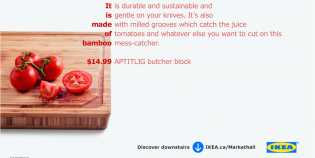Not so long ago Domino’s Pizza was in a bit of a funk.
Once viewed as an innovator in its category – it has been credited with inventing pizza delivery in the United States — the business and product had evolved very little over the years.
It took three decades, for instance, for Domino’s to diversify its menu beyond pizza and pop when competitors were offering wings, salads and Italian style bread, and 50 years to change its recipe.
“Domino’s created pizza delivery, but while founded on pizza innovation, change was not in their DNA,” Alex Guerri told attendees of the Institute of Communication Agencies’ annual Future Flash conference.
The competition caught up and Domino’s was forced to “spray and pray” with limited-time offers and product trials for short-term sales boosts, said Guerri, VP-account director at Crispin Porter + Bogusky – the restaurant chain’s agency of record. But, things were about to change.
Reinvention became paramount after two years of declining sales and a 2009 consumer study from loyalty research firm Brand Keys that had the chain tied with Chuck E. Cheese’s for last in taste amongst major pizza chains.
Faced with a lackluster product and declining stock prices, Domino’s Pizza and its agency got to work on a turnaround plan that involved trust, courage and overcoming the resistance to change.
During their presentation Thursday morning, Guerri and his colleague Andrew Lincoln shared what they called the seven tenets of Domino’s transformation into a digital company.
- Embrace revolution: “You have to start thinking in a revolutionary way if you’re really going to change your fortunes… If you really want to grow the pie versus just steal a share of it you need to think in a revolutionary way to do that,” said Guerri.
- Practice uncommon honesty: Facing its criticism head-on, Domino’s spent three years reformulating its pizza recipe and in 2010 supported it with an advertising campaign that featured consumers ruthlessly bashing its old recipe. Instead of hiding the hate, Domino’s embraced it. “It was a major reset moment and it kind of lead to a new way of thinking,” said Lincoln.
- Define your why: Seems obvious, right? Not always. Few companies, said Guerri, could explain why they exist. “At the heart of it all, we think Domino’s are the biggest pizza fanatics in the world and they actually believe pizza is magic, so we’re driven to bring magic to all aspects of the pizza experience.”
- Take bold action: It’s not enough anymore to tell stories about your brand, these stories need to be rooted in action to attract brand devotees, said Guerri. This way of thinking led the brand and its agency to Times Square in New York City where it ran an electronic ticker displaying in real-time what consumers really thought of the brand – good and bad. The brand also encouraged consumers to share pictures of their pizza at ShowUsYourPizza.com for the chance to have it featured in an advertisement. It resulted in this:
- Challenge everything: Fuelled by its success, Domino’s turned to technology to keep the momentum. “We decided we wanted to behave like a technology company that sold pizza,” said Guerri. That meant looking outside the pizza category for inspiration and to set lofty goals. Domino’s wanted to move from less than 20% online ordering to over 50% by 2015. So Domino’s launched a pizza tracker that allowed consumers to follow the progress of their delivery order from the oven to their door. “At a time when people were sceptical about ordering food online, this was something that really helped connect them to their stores and drive momentum in online ordering,” said Guerri.
- Get ‘innovation ready’: Domino’s started to see the benefits of these initiatives. Online ordering increased and so did positive sentiment around the brand. As the company aligned its advertising and marketing team with its ecommerce and tech team, CP+B also looked at how its team was structured. The agency to this day always includes an integrated producer and technologist in briefs to yield different ways of thinking.
- Innovation is advertising: Introducing and adopting these new technologies aren’t just about driving orders, said Guerri. A lot the above the line work the agency now produces in support of its innovations or technologies doesn’t include a promotional offer at the end, which is rare for work in the QSR segment.
For instance, the brand’s latest innovation is its DXP pizza delivery vehicle – a modified Chevrolet Spark equipped with a warming oven and special slots for dipping sauce and soda.
Domino’s promoted it with this 60-second spot:
These major campaigns and digital stories are more about driving digital growth. They have a halo effect that drive sales company-wide, said Guerri.
While this may be true, the effect these initiatives have had on the bottom line are impressive. Domino’s ecommerce platforms in the U.S. alone account for more than US$2 billion in sales per year, or $4 billion globally, said Guerri.
Future Flash is an annual two-day leadership conference in Muskoka, Ont. This year’s event examined “the transforming landscape of marketing, as the pendulum swings from storytelling to the systemic thinking of technology.”
Speakers included Susan Credle, global chief creative officer at FCB, Kenneth Klopp, co-founder of The North Face and Noah Brier, co-founder of Percolate.










